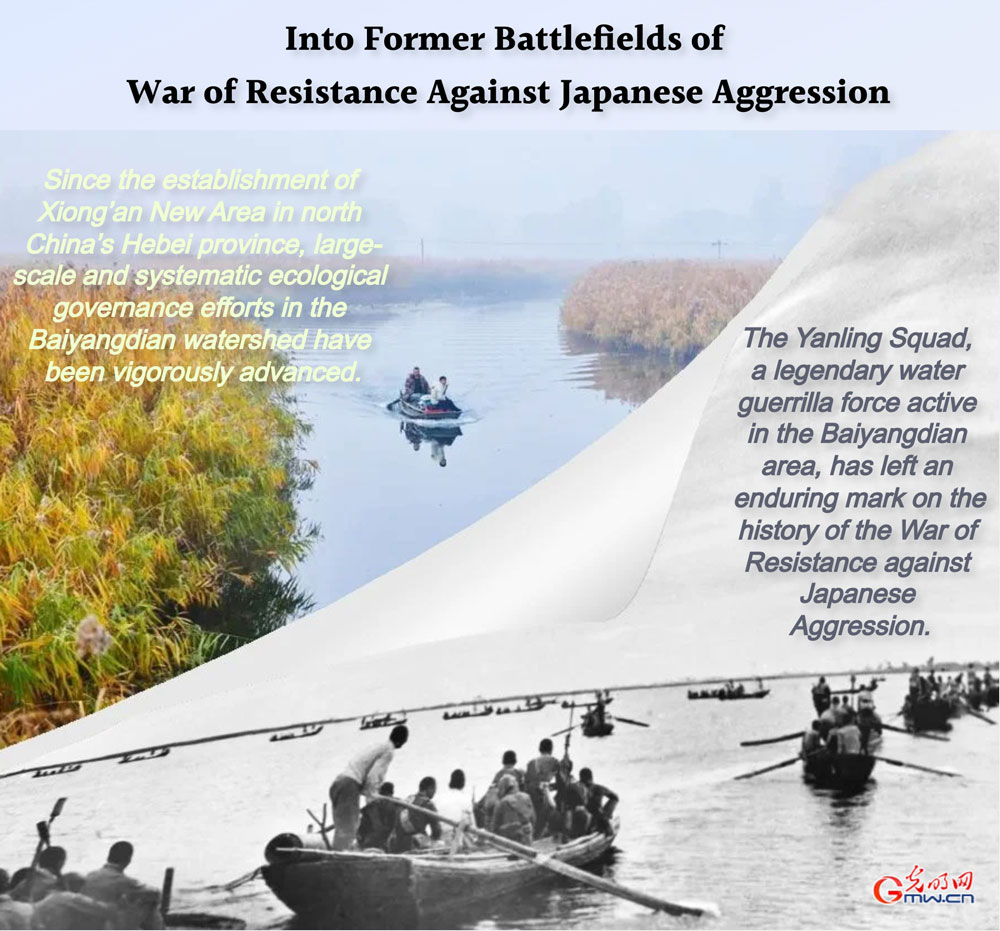


After the July 7th Incident, the Japanese invaders extended their claws southward, successively capturing places such as Zhuozhou and Baoding in north China's Hebei Province. In the summer of 1938, Baiyangdian fell, and the important waterway connecting Tianjin and Baoding was seized by the invaders.
How could we allow the Japanese to act with impunity! The county committees of Anxin and Xin'an actively mobilized the masses and formed anti-Japanese forces, leading to the creation of the Yanling Squad.
The members of the Yanling Squad were local hunters who had been active in Baiyangdian. They were familiar with the local terrain, excellent in water skills, accurate in marksmanship, and brave in combat.
Why was it called the Yanling Squad?
Back then, to prevent the gunpowder in the barrel from getting damp, the hunters often inserted a wild goose feather into the firing mechanism of their shotguns. Additionally, when they went geese-hunting, their small boats moved in a 'V' formation, resembling a flying flock — hence the name “Yanling Squad”.
The main weapon of the Yanling Squad was the "Datai Gan", a type of homemade hunting rifle. Two of them were mounted side by side on a raft boat, each over 2 meters long, with gun barrels filled with gunpowder and iron sand. One shot would hit a large area, and the power was immense.
With their fast-moving boats and accurate marksmanship, Yanling Squad members killed Japanese invaders, destroyed watchtowers, intercepted enemy boats, dismantled strongholds, eliminated traitors, staging one thrilling episode after another to defend their homeland in the reed marshes.
The most spectacular battle fought by the Yanling Squad was the ambush of the enemy's supply ship in 1943.
In the autumn of 1943, Japanese invaders launched a large-scale "mopping-up" campaign against the Jin-Cha-Ji Anti-Japanese Base Area. They continuously transported military supplies from Tianjin to Baoding via the Daqing River and Baiyangdian waterways. To cut off the enemy’s waterborne supply line, higher authorities ordered the Yanling Squad to ambush the enemy.
Yanling Squad leader Zheng Shaochen dispatched scout Zhao Bo to gather intelligence from the enemy's Zhaobeikou stronghold. He learned that on the morning of October 4, the enemy was going to transport a batch of munitions to Baoding. The enemy's transport convoy consisted of three escort boats, a dozen Japanese soldiers, and over 100 puppet troops.
The river branches and reed marshes were the best ambush sites! In the early morning, the Yanling Squad and various militia units set up an ambush circle in the reed thickets on the north bank of the Daqing River, west of Zhaozhuangzi Village and east of Wangjiazhai Village. The militia commanded by the district committee was responsible for dealing with the front transport ships, while the Yanling Squad was assigned to deal with the enemy on the three escort ships.
To ensure a complete victory, the Yanling Squad made meticulous arrangements: Sun Ge and two other members were responsible for killing Japanese commander Hatsushika Saburo; Shi Laogang, who had been a machine gunner, was responsible for seizing the machine gun; Zheng Shaochen was responsible for shooting down the "lookout post" and firing a gun as a signal...
Everything was ready, just waiting for the enemy to enter the ambush zone.
At 8 o'clock, the enemy fleet came into view. The transport ships slowly passed by, and the guerrillas waited silently... The first escort ship arrived! At the front of the ship was a lookout tower raised about 10 feet above the deck, and a Japanese soldier was peering through it. Zheng Shaochen shouted, "Go!" His small boat sped towards the enemy ship, and at the same time, he fired a shot, and the Japanese sentry fell.
The gunshot was the signal. Immediately, the "Datai Gan" guns roared to life, catching the enemy off guard. Sun Ge and two other Yanling Squad members saw their chance and leaped onto the enemy’s ship, where they encountered a Japanese officer coming out of the cabin, waving a pistol. One squad member fired a shot, the bullet grazing the Japanese officer's right arm. The Japanese officer’s right arm was injured, yet he still held his gun in his left hand and tried to resist. Sun Ge closed in, blocking the officer's elbow with one hand and grabbing the gun with the other. When he lowered his head, he saw the officer’s gun and hand pressed against his abdomen. Without hesitation, Sun Ge bit down hard on the Japanese officer’s thumb, severing half of the finger. Several team members rushed forward, disarmed the enemy officer, tied him up, and captured him alive.
They weren’t aware until later that this Japanese officer was none other than Japanese commander, Hatsushika Saburo.
At this point, Shi Laogang had also seized the enemy's machine gun. Soon, the Yanling Squad had gained control of two of the enemy's escort boats.
The enemy, having regained their senses, began to fiercely counterattack, with machine gun fire sweeping over. The Yanling Squad members could not approach. Shi Laogang used the captured machine gun to suppress enemy fire, while Zheng Shaochen led several team members to maneuver around the enemy’s rear, forming a pincer attack. In no time, dozens of rifles, handguns, and "Datai Gan" guns were all aimed at the enemy’s boats. The Japanese and puppet soldiers, with no way out, were forced to surrender.
The battle ended in less than 40 minutes. The Yanling Squad lost 3 members, annihilated the enemy’s river defense battalion, killed 10 Japanese invaders, and captured Japanese commander Hatsushika Saburo and the puppet army river defense battalion leader alive. In this battle, the Yanling Squad seized 2 machine guns, over 100 rifles and pistols, more than 8,000 grenades, over 20,000 bullets, and various other military supplies. Afterwards, the Japanese supply line from Tianjin to Baoding was completely severed, and the Yanling Squad members also replaced their "Datai Gan" guns with modern firearms.
From its establishment in 1939 to its cooperation with the main forces in liberating Xin’an new county-seat in 1945, the Yanling Squad fought over 70 battles, killing 25 Japanese soldiers, capturing 30 alive, killing 250 puppet troops, and capturing over 500. They seized more than 500 rifles, 48 pistols, 3 machine guns, 2 cannons, and large quantities of military supplies.
With the support of the people, the Yanling Squad grew and became tempered in the struggle of blood and fire. This resounding name spread throughout the country and was forever etched in the history of the War of Resistance against Japanese Aggression.
Comrade Mao Zedong pointed out in “On Protracted War”: "The Chinese peasants have very great latent power; properly organized and directed, they can keep the Japanese army busy twenty-four hours a day and worry it to death." The story of the Yanling Squad verified this truth.
Today, the history of the Yanling Squad is quietly displayed at the Yanling Squad Memorial Hall in Baiyangdian. Not far from the memorial hall is Xiaozhangzhuang Village of Anxin County. Though the village roads are narrow, they are very clean, with large water tanks painted with landscape scenes dotting the roadside. Every household has willow trees, and the village is peaceful and harmonious—a true picture of water village folk customs!
When we struck up a conversation with villager Zhang Fuqing, the old man, upon learning that we were there to interview about the Yanling Squad, immediately opened up. "Chopping off a Japanese officer's head," "outsmarting the enemy to seize the Type 38 rifle," "storming the Dazhangzhuang watchtower"... The vivid details of these battles he recounted captivated us.
The old man was very proud: "Zhang Yinqing, a member of the Yanling Squad, was from our village. When I was a child, I used to stay around him all day long, saying 'Grandpa, tell us a story', and he would. That's how I remembered it."
Standing at the village dock, as the spring breeze passed, the reeds gently swayed. The shimmering ripples on the water's surface sparkled under the sunlight, and everything around seemed so peaceful and harmonious.
Village Party Secretary Zhang Zhanguo shared with us the changes in Baiyangdian: “For a time, nearby villages developed industrial projects, polluting the once pristine wetland and causing the water levels to drop. We learned the hard way that ‘a good environment leads to a good life’. In response to the government's call, we launched the “Three Cleanings and One Green” initiative, making sure no wastewater enters the lake. Moreover, in recent years, the country has continuously implemented ecological water replenishment, and now, the environment has improved continuously. Tourists are also coming in greater numbers, and we can make money by developing tourism right at our doorstep."
Standing on the shores of Baiyangdian, looking towards the horizon, a new city is rising—this is the Xiong’an New Area.
By Guangming Daily reporter Bao Han, Geng Jiankuo, Chen Yuanqiu (Guangming Daily Page 01, April 23, 2025)
Translated by Xiong Jian
点击右上角![]() 微信好友
微信好友
 朋友圈
朋友圈

请使用浏览器分享功能进行分享
